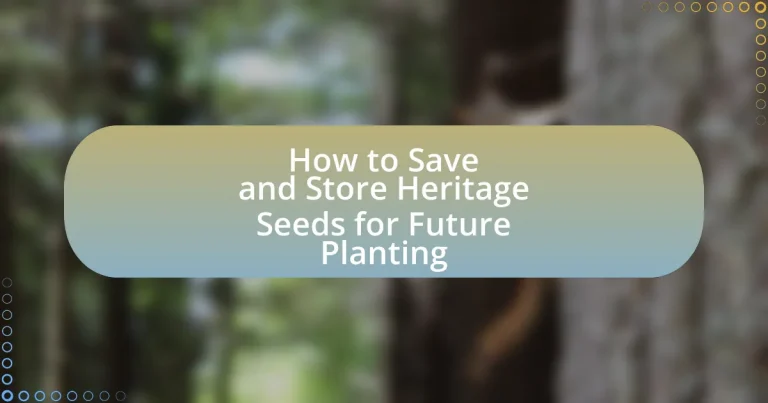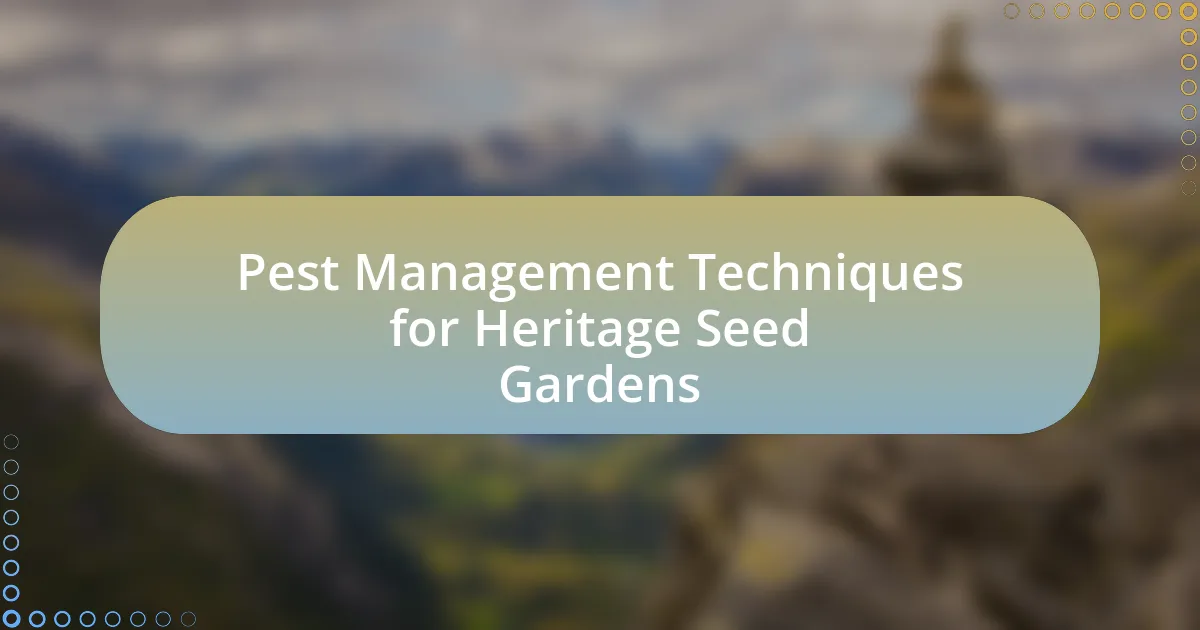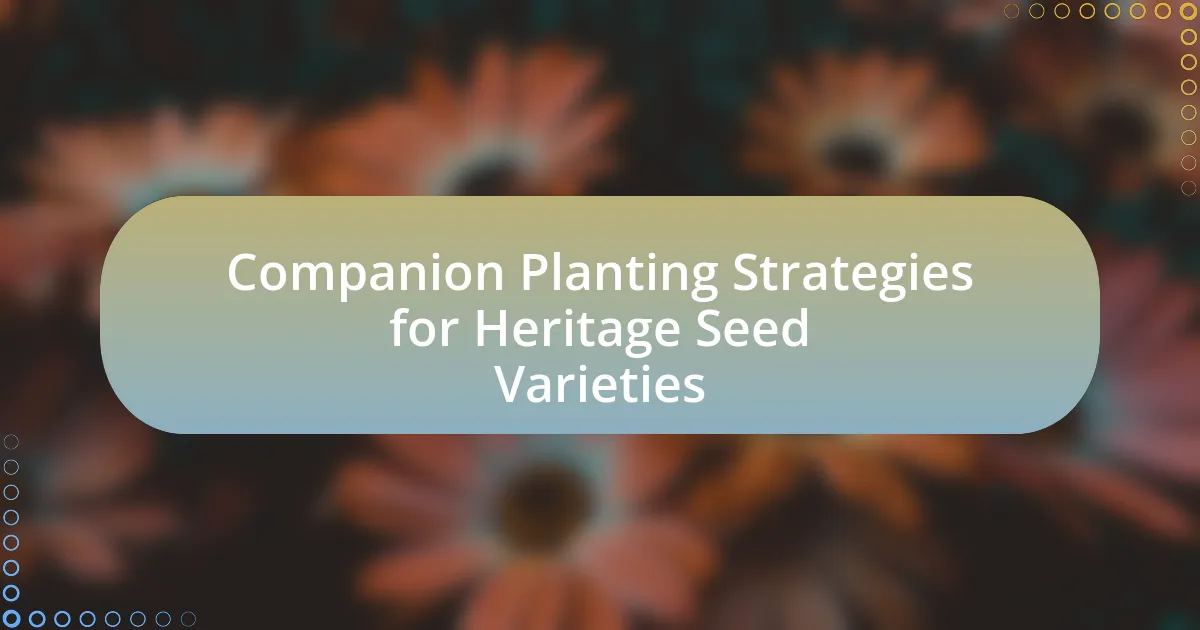Heritage seeds are traditional, open-pollinated varieties that have been cultivated for their unique traits and adaptability, playing a crucial role in preserving agricultural biodiversity and promoting sustainable farming practices. This article outlines the importance of heritage seeds, their differences from hybrid and GMO seeds, and the characteristics that define them. It also provides practical guidance on how to effectively save and store heritage seeds, including best practices for seed collection, cleaning, and storage conditions to ensure long-term viability. Additionally, the article highlights the risks associated with losing heritage seeds and emphasizes their significance in maintaining food security and ecological resilience.

What are Heritage Seeds and Why are They Important?
Heritage seeds are traditional varieties of seeds that have been passed down through generations, often cultivated for their unique characteristics and adaptability to local environments. They are important because they contribute to biodiversity, preserve genetic diversity in agriculture, and support sustainable farming practices. Heritage seeds often have better flavor and nutritional value compared to modern hybrids, and they allow farmers and gardeners to save seeds from their crops for future planting, thus promoting self-sufficiency and resilience in food systems.
How do Heritage Seeds differ from Hybrid and GMO Seeds?
Heritage seeds are open-pollinated varieties that have been passed down through generations, while hybrid seeds are created through controlled pollination between two different parent plants, and GMO seeds are genetically modified organisms that have had their DNA altered in a laboratory. Heritage seeds maintain genetic diversity and can be saved and replanted, preserving traditional traits, whereas hybrid seeds often do not produce offspring with the same characteristics as the parent plants, and GMO seeds are engineered for specific traits, such as pest resistance or herbicide tolerance, which can lead to ecological concerns. The distinction lies in their breeding methods and implications for biodiversity and agricultural practices.
What characteristics define Heritage Seeds?
Heritage seeds are defined by their open-pollinated nature, which allows them to be naturally pollinated and produce seeds that are true to type. These seeds are typically heirloom varieties, meaning they have been passed down through generations, often for at least 50 years, and are valued for their genetic diversity, flavor, and adaptability to local growing conditions. Additionally, heritage seeds are not genetically modified and are often grown using traditional farming practices, which contribute to their sustainability and resilience in various environments.
Why should gardeners choose Heritage Seeds over other types?
Gardeners should choose Heritage Seeds because they offer genetic diversity and adaptability, which are essential for sustainable gardening. Heritage Seeds are open-pollinated, meaning they can be saved and replanted year after year without losing their unique traits, unlike hybrid seeds that often produce inconsistent results. This characteristic allows gardeners to cultivate plants that are better suited to their local environment and climate conditions, enhancing resilience against pests and diseases. Furthermore, Heritage Seeds contribute to preserving biodiversity, as they represent traditional varieties that may be at risk of extinction. Studies have shown that maintaining genetic diversity in crops can lead to improved yields and better resistance to environmental stresses.
What role do Heritage Seeds play in biodiversity?
Heritage seeds play a crucial role in biodiversity by preserving genetic diversity within plant species. These seeds, often heirloom varieties, maintain traits that are well-adapted to local environments and agricultural practices, which contributes to ecosystem resilience. For instance, heritage seeds can withstand pests and diseases better than modern hybrids, ensuring a more stable food supply. Additionally, they support a wider range of plant varieties, which is essential for maintaining healthy ecosystems and promoting sustainable agriculture. The preservation of heritage seeds is vital for future generations, as it safeguards the genetic resources necessary for adapting to changing environmental conditions.
How do Heritage Seeds contribute to sustainable agriculture?
Heritage seeds contribute to sustainable agriculture by preserving genetic diversity and promoting resilience in crops. These seeds are open-pollinated and have been passed down through generations, allowing farmers to cultivate varieties that are well-adapted to local conditions. This adaptability reduces the need for chemical inputs and enhances soil health, as heritage crops often require fewer resources and are more resistant to pests and diseases. Studies indicate that using diverse seed varieties can lead to improved yields and better food security, as demonstrated by research from the Food and Agriculture Organization, which highlights the importance of genetic diversity in agricultural systems for sustainability.
What are the risks of losing Heritage Seeds?
The risks of losing heritage seeds include the loss of genetic diversity, which can lead to increased vulnerability of crops to pests and diseases. Heritage seeds often possess unique traits that have adapted to specific local conditions over generations, and their extinction can result in a reliance on a limited number of commercial seed varieties, reducing resilience in food systems. According to the Food and Agriculture Organization, approximately 75% of crop diversity has been lost since the 1900s, highlighting the critical need to preserve heritage seeds to maintain agricultural biodiversity and food security.

How to Save Heritage Seeds Effectively?
To save heritage seeds effectively, collect seeds from healthy, mature plants at the end of the growing season. Ensure that the seeds are fully dried and free from moisture to prevent mold and decay. Store the seeds in a cool, dark, and dry environment, ideally in airtight containers such as glass jars or vacuum-sealed bags, to maintain their viability. Research indicates that proper storage conditions can extend seed longevity significantly, with some heritage seeds remaining viable for decades when stored correctly.
What are the best practices for collecting seeds from plants?
The best practices for collecting seeds from plants include selecting mature seeds, timing the collection appropriately, and ensuring proper drying and storage. Mature seeds are typically found in fully developed fruits or pods, which should be harvested when they are dry and brown, indicating readiness. Timing is crucial; seeds should be collected on a dry day to minimize moisture content, which can lead to mold during storage. After collection, seeds must be thoroughly dried in a cool, dark place to prevent spoilage. Finally, storing seeds in airtight containers in a cool, dark environment extends their viability, with some seeds lasting for several years when stored correctly.
How do you determine the right time to harvest seeds?
To determine the right time to harvest seeds, observe the seed maturity indicators such as color change, dryness, and seed firmness. For instance, seeds typically change color from green to brown or tan when they are ready for harvest. Additionally, mature seeds feel hard and dry to the touch, indicating they have reached their full development. Research shows that harvesting seeds at the correct time maximizes germination rates and preserves genetic integrity, as seeds harvested too early may not germinate effectively, while those harvested too late may be prone to damage or loss.
What methods can be used to collect seeds without damaging the plant?
To collect seeds without damaging the plant, gentle techniques such as hand-picking, using scissors, or employing seed collection bags are effective. Hand-picking allows for selective harvesting of ripe seeds while minimizing disturbance to the plant. Using scissors can help cut seed pods or fruits cleanly, reducing the risk of injury to the plant. Seed collection bags can be placed over developing seed heads to catch seeds as they naturally fall, preventing them from scattering and ensuring the plant remains intact. These methods are widely recognized in horticulture for preserving plant health while effectively gathering seeds.
How should seeds be cleaned and prepared for storage?
Seeds should be cleaned and prepared for storage by removing any debris, dirt, or damaged seeds to ensure their viability. Begin by gently shaking or rubbing the seeds to dislodge any attached materials, followed by rinsing them in water if necessary. After cleaning, seeds should be dried thoroughly to prevent mold growth during storage; this can be achieved by spreading them out on a paper towel or a mesh screen in a cool, dry area. Properly dried seeds can then be stored in airtight containers, such as glass jars or vacuum-sealed bags, in a cool, dark place to maintain their viability for future planting.
What techniques are effective for cleaning seeds?
Effective techniques for cleaning seeds include air drying, using screens, and employing water flotation methods. Air drying involves spreading seeds in a single layer to remove moisture and debris, which is essential for preventing mold. Screens can separate seeds from chaff and larger particles, ensuring a cleaner product. Water flotation methods utilize the principle that lighter, non-viable seeds float while heavier, viable seeds sink, allowing for easy separation. These methods are widely recognized in seed saving practices, as they enhance seed quality and longevity.
How can you ensure seeds are dry before storage?
To ensure seeds are dry before storage, place them in a well-ventilated area with low humidity for several days. This method allows moisture to evaporate effectively, reducing the risk of mold and decay. It is essential to monitor the moisture content, aiming for a level below 8% for optimal storage conditions. Using a moisture meter can provide accurate readings, confirming that seeds are adequately dried before sealing them in airtight containers for long-term preservation.

What are the Best Storage Methods for Heritage Seeds?
The best storage methods for heritage seeds include keeping them in a cool, dark, and dry environment, ideally at temperatures between 32°F and 41°F (0°C to 5°C) with low humidity levels. Using airtight containers, such as glass jars or vacuum-sealed bags, helps prevent moisture and pests from damaging the seeds. Additionally, labeling containers with the seed variety and date of storage ensures proper organization and tracking. Research indicates that seeds stored under these conditions can maintain viability for several years, with some heritage seeds remaining viable for decades when properly stored.
How does temperature and humidity affect seed storage?
Temperature and humidity significantly impact seed storage by influencing seed viability and longevity. High temperatures can accelerate seed aging and reduce germination rates, while low temperatures generally enhance seed longevity. Humidity levels also play a crucial role; excessive moisture can lead to mold growth and seed deterioration, whereas low humidity can cause seeds to dry out and lose viability. Research indicates that seeds stored at temperatures below 10°C and relative humidity levels around 20% can maintain viability for extended periods, demonstrating the importance of controlling these environmental factors for effective seed preservation.
What are the ideal conditions for storing Heritage Seeds?
The ideal conditions for storing Heritage Seeds include a cool, dark, and dry environment. Specifically, seeds should be kept at temperatures between 32°F and 41°F (0°C to 5°C) and in low humidity, ideally around 20% or less. These conditions help to maintain seed viability and prevent mold or decay. Research indicates that seeds stored under these conditions can remain viable for several years, with some varieties lasting decades. Proper storage containers, such as airtight glass jars or vacuum-sealed bags, further enhance preservation by protecting seeds from moisture and pests.
How can you monitor and maintain these conditions?
To monitor and maintain the conditions for saving and storing heritage seeds, regularly check temperature and humidity levels in the storage environment. Ideal conditions for seed storage typically require a temperature below 50°F (10°C) and humidity levels around 20%. Use a hygrometer to measure humidity and a thermometer for temperature. Additionally, inspect seeds periodically for signs of mold or pests, ensuring that they remain dry and free from contaminants. Research indicates that maintaining these specific conditions can significantly enhance seed viability, with studies showing that seeds stored under optimal conditions can retain germination rates above 80% for several years.
What containers are best for storing seeds long-term?
The best containers for storing seeds long-term are airtight glass jars, vacuum-sealed bags, and metal tins. Airtight glass jars prevent moisture and pests from affecting the seeds, while vacuum-sealed bags eliminate air, which can lead to seed degradation. Metal tins also provide a protective barrier against light and moisture. Research indicates that seeds stored in these types of containers can maintain viability for several years, with some seeds remaining viable for decades when kept in optimal conditions.
What materials should be avoided when choosing seed storage containers?
When choosing seed storage containers, materials such as plastic, cardboard, and metal should be avoided. Plastic can retain moisture and promote mold growth, while cardboard is susceptible to pests and moisture damage. Metal containers can cause condensation, leading to rust and seed deterioration. These materials compromise the integrity of the seeds, making them less viable for future planting.
How can you label and organize your seed collection effectively?
To label and organize your seed collection effectively, use clear, consistent labeling methods and a systematic storage approach. Label each seed packet with the plant name, variety, date of collection, and any specific growing instructions. Organize the packets in a dedicated storage container, such as a seed box or binder, categorized by plant type or growing season. This method ensures easy access and identification, reducing the risk of planting errors. Research indicates that organized seed collections can improve planting success rates by up to 30%, as noted in studies on agricultural efficiency.
What are common mistakes to avoid when saving and storing seeds?
Common mistakes to avoid when saving and storing seeds include improper drying, inadequate labeling, and unsuitable storage conditions. Improper drying can lead to mold and seed rot, as seeds must be fully dried to a moisture content of around 8-10% before storage. Inadequate labeling can result in confusion about seed varieties, which is critical for maintaining heritage traits. Unsuitable storage conditions, such as high humidity or fluctuating temperatures, can degrade seed viability; seeds should be stored in a cool, dark, and dry environment to maximize longevity.
How can improper storage affect seed viability?
Improper storage can significantly reduce seed viability by exposing seeds to unfavorable conditions such as excessive moisture, extreme temperatures, and light. Seeds stored in high humidity can absorb moisture, leading to mold growth and decay, which can render them non-viable. For instance, research indicates that seeds stored at 15% moisture content can lose viability within a year, while those at 5% can remain viable for decades. Additionally, temperatures above 20°C can accelerate metabolic processes, causing seeds to age faster. Therefore, maintaining optimal storage conditions is crucial for preserving seed viability over time.
What are the signs that seeds have gone bad?
Seeds have gone bad if they exhibit signs such as discoloration, mold growth, or an off-putting odor. Discoloration indicates deterioration, while mold suggests moisture exposure, which can compromise seed viability. An off-putting odor often signals decay or spoilage. Additionally, seeds that feel excessively dry or brittle may have lost their viability. These signs are critical for determining the quality of seeds, as viable seeds should be firm, dry, and free from any visible defects or unusual smells.
What practical tips can help ensure successful seed saving and storage?
To ensure successful seed saving and storage, select seeds from healthy, mature plants and allow them to dry completely before storage. Proper drying prevents mold and decay, which can compromise seed viability. Store seeds in a cool, dark, and dry environment, ideally in airtight containers to protect against moisture and pests. For example, using glass jars or vacuum-sealed bags can significantly extend seed longevity. Additionally, label containers with the seed type and date of collection to keep track of freshness. Research indicates that seeds stored under optimal conditions can remain viable for several years, with some lasting decades.




